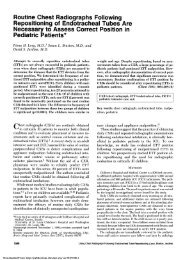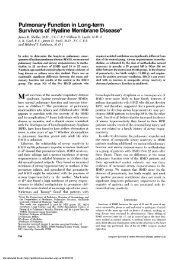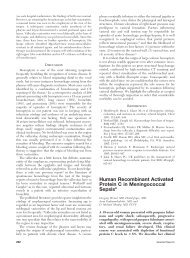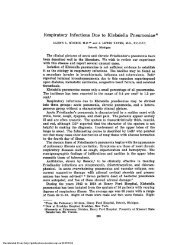Fiberoptic Bronchoscopy in Bronchial Asthma*
Fiberoptic Bronchoscopy in Bronchial Asthma*
Fiberoptic Bronchoscopy in Bronchial Asthma*
You also want an ePaper? Increase the reach of your titles
YUMPU automatically turns print PDFs into web optimized ePapers that Google loves.
<strong>Fiberoptic</strong> <strong>Bronchoscopy</strong> <strong>in</strong> <strong>Bronchial</strong><strong>Asthma*</strong>A Word of CautionSteoen A. Sahn, M.D., F.C.C.P.; and Churles Scogg<strong>in</strong>, M.D.**Three <strong>in</strong>stances of <strong>in</strong>tense laryngospasm and bronchospasmoccurred as a result of fiberoptic bronchoscopicexam<strong>in</strong>ation <strong>in</strong> three patients with quiescent bronchialasthma. The <strong>in</strong>dications for the procedure were hemoptysis<strong>in</strong> one patient and lobar collapse <strong>in</strong> two. It is likelythat vagally mediated reflex laryngospasm and bronchoconstrictionoccur when irritant receptora are mechani-cally stimulated by the bronchoscope. Therefore, <strong>in</strong> theasthmatic population with its <strong>in</strong>creased airway reactivity,<strong>in</strong>dications for fiberoptic bronchoscopy should be absolute,and the procedure sbould be performed under optimalcondition& A retionale for m<strong>in</strong>imiz<strong>in</strong>g the risk of thisprocedure <strong>in</strong> patients with bronchial asthma is discussed.<strong>in</strong>ce the description of the flexible fiberopticbronchoscope for the early diagnosis of peripherallylocated endobronchial lesions by Ikeda et all<strong>in</strong> 1968, the diagnostic and therapeutic potential ofthis <strong>in</strong>strument has been widely expanded. Due toits relative technical simplicity and m<strong>in</strong>imal patientdiscomfort, this <strong>in</strong>strument has been used for bronchialbrush biopsies, - transbronchial-pulmonary biopsies,evaluation of hemoptysis, treatment ofatelectasis, and <strong>in</strong> patients with respiratory failure.*Major complications and mortality from fiberopticbronchoscopic exam<strong>in</strong>ation have been reported tobe quite low. However, patients with bronchialasthma may be at <strong>in</strong>creased risk dur<strong>in</strong>g this procedure.Dur<strong>in</strong>g a four-month period, we encounteredthree episodes of severe laryngospasm and bronchospasm,one lead<strong>in</strong>g to death, <strong>in</strong> three consecutivefiberoptic bronchoscopic exam<strong>in</strong>ations <strong>in</strong> asthmaticsubjects. The purpose of this report is to stress thepotential risk <strong>in</strong>volved <strong>in</strong> bronchoscopic exam<strong>in</strong>ationof asthmatic patients and to discuss the possiblemechanisms <strong>in</strong>volved <strong>in</strong> the production of laryngc~spasm and bronchospasm. Measures to m<strong>in</strong>imizerisk <strong>in</strong> these patients will also be reviewed.A 54year-old man entered Colorado General Hospital,Denver, for evaluation of hemoptysis. The patient had had'From the Division of Pulmona Medic<strong>in</strong>e, Department ofMedic<strong>in</strong>e, University of Coloraro Medical Center, Denver.''Teach<strong>in</strong>g and Research Scholar, American College ofPhysicians.Manuscript received June 20; revision accepted July 25.Repr<strong>in</strong>t requests: Dr. Scogg<strong>in</strong>, 4200 East N<strong>in</strong>th Avenue,Denuer 80220bronchial asthma s<strong>in</strong>ce childhood with numerous hospitalizationsfor status asthmaticus. He had been treated withtheophyll<strong>in</strong>e preparations and occasional courses of corticesteroidtherapy. Three months prior to admission, the patientnoted blood-streaked sputum. Fever, weight loss, and chestpa<strong>in</strong> were not present. The patient's asthma was under goodcontrol with oral adm<strong>in</strong>istration of theophyll<strong>in</strong>e. F<strong>in</strong>d<strong>in</strong>gsfrom physical exam<strong>in</strong>ation were normal. Laboratory exam<strong>in</strong>ationrevealed a leukocyte count of 9,70O/cu mm, with 12percent eos<strong>in</strong>ophils. Arterial blood gas analysis with the patientbreath<strong>in</strong>g ambient air showed a pH of 7.42, an arterialcarbon dioldde tension (PaC02) of 33 mm Hg, and anarterial oxygen pressure ( Pa02 ) of 85 mm Hg ( normal forDenver, PaC02 of 35 2 2 mm Hg and Pa02 of 70 f 5 mmHg). A chest roentgenogram was normal. After the adm<strong>in</strong>istrationof 30 mg of code<strong>in</strong>e and 0.4 mg of atrop<strong>in</strong>e <strong>in</strong>tramuscularly,the 6beroptic bronchoscope was passed transnasallywithout difficulty. Adequate local anesthesia to thevocal cords and bronchial mucosa was effected with a 1percent solution of lidoca<strong>in</strong>e ( Xyloca<strong>in</strong>e ) . Inspection of thevocal cords and the lobar, segmental, and subsegmentalbronchi required approximately five m<strong>in</strong>utes and revealed noabnormalities. Upon withdrawal of the bronchascope, thepatient developed <strong>in</strong>tense laryngospasm and bronchospasm.Stridor, use of the accessory respiratory muscles, and <strong>in</strong>tercostalretraction were noted. While the patient was breath<strong>in</strong>g4 L of oxygen per m<strong>in</strong>ute by nasal cannula, arterial blood gasanalysis showed a pH of 7.48, a PaCOz of 28 mm Hg, and aPa02 of 60 mm Hg. The patient was given 0.5 ml ofterbutal<strong>in</strong>e subcutaneously, <strong>in</strong>haled ep<strong>in</strong>ephr<strong>in</strong>e, and an <strong>in</strong>travenousdrip <strong>in</strong>fusion of am<strong>in</strong>ophyll<strong>in</strong>e at 1 mg/kg of bodyweight per hour. Thirty m<strong>in</strong>utes after <strong>in</strong>itiation of therapy,the patient's respiratory status had improved. No furthersequelae of the bronchoscopic exam<strong>in</strong>ation were noted, andno cause for the patient's hemoptysis was found.A 48-year-old woman was transferred to Colorado GeneralHospital for evaluation of bronchial asthma with persistentleft lower lobe atelectasis and fever. Physical exam<strong>in</strong>ationdisclosed dullness to percussion, decreased fremitus, anddecreased breath sounds at the left pulmonary base. Auscul-CHEST, 69: 1, JANUARY, 1976 FIBEROPTIC BRONCHOSCOPY IN BRONCHIAL ASTHMA 39Downloaded From: http://publications.chestnet.org/ on 03/29/2014
sult of a comb<strong>in</strong>ation of factors: compromised airwayby the bronchoscope, underly<strong>in</strong>g respiratorydisease, respiratory depression secondary to premedication,adverse effects of topical anesthesiaand suction<strong>in</strong>g, and possibly subepithelial receptor-mediated reflexes caus<strong>in</strong>g bronchoconstrictionand ventilation-perfusion disturbances. Karetzkyet a120 have shown that si@cant hypoxernia occurredwhen the bronchoscopic tip was at the levelof the canna, an area known to have a high concentrationof subepithelial receptor sites.Patient 1 underwent bronchoscopic exam<strong>in</strong>ationfor evaluation of hemoptysis at a time when hisasthma was <strong>in</strong> remission. Despite a modest dose ofatrop<strong>in</strong>e, adequate local anesthesia to preventcough, and supplemental oxygen, laryngospasm andbronchospasm developed. The second patient, whounderwent bronchoscopic exam<strong>in</strong>ation for persistentleft lower l~be atelectasis and fever, was also <strong>in</strong>remission. Premedication and local anesthesia didnot prevent a severe upper and lower airway reactionto <strong>in</strong>strumentation, lead<strong>in</strong>g to irreversible hypoxicbra<strong>in</strong> damage. Patient 3 underwent bronchoscopicexam<strong>in</strong>ation on two occasions, one withthe fiberoptic <strong>in</strong>strument and the other under generalanesthesia with the rigid bronchoscope, forpersistent left upper lobe illapse <strong>in</strong> the face of<strong>in</strong>tensive medical and physical therapy. Bronchospasmoccurred with both the fiberoptic and rigidbronchoscope, which suggests that mechanical imtationwas the <strong>in</strong>itiat<strong>in</strong>g factor; however, respiratoryfailure after the straight bronchoscopic exam<strong>in</strong>ationmay have been due to the additive adverseeffects of halothane. This anesthetic has been shownto depress hypercapnic ventilatory drives, <strong>in</strong>creasethe level of alveolar carbon dioxide tension atwhich respiration beg<strong>in</strong>s,22 and require a prolongedrecovery tirneaZsIn all patients, modest doses of atrop<strong>in</strong>e weregiven as premedication, adequate local anesthesiawas provided with lidoca<strong>in</strong>e, and supplemental oxygenwas provided to ma<strong>in</strong>ta<strong>in</strong> normal values ofPaO2. We hypothesize that <strong>in</strong> certa<strong>in</strong> patients withbronchial asthma, <strong>in</strong>tense laryngospasm and bronchospasmare triggered by the mechanical manipulationof the fiberoptic bronchoscope aga<strong>in</strong>st thelarynx and bronchial mucosa and is reflexly mediated,at least partially, by vagal pathways. Possiblylarger doses of atrop<strong>in</strong>e (1 to 2 mg) adm<strong>in</strong>isteredparenterally or by <strong>in</strong>halation might ameliorate oreven obliterate these reflex responses. Atrop<strong>in</strong>e reducesthe occurrence of laryngospasm dur<strong>in</strong>g generalanesthesia. This appears to be due to the reductionof respiratory-tract secretions that can causereflex laryngospasm and not to blockade of laryngealskeletal m~scle.~The decision to perform fiberoptic bronchoscopicprocedures <strong>in</strong> patients with bronchial asthma shouldbe based on absolute <strong>in</strong>dications, and the procedureshould be undertaken with great caution. These patientsare <strong>in</strong> an extremely high-risk group for thedevelopment of laryngospasm and bronchospasm.Unless there are compell<strong>in</strong>g factors, the procedureshould be performed only when the patient's asthmais quiescent and he is <strong>in</strong> a state of maximum bronchodilation.Large doses of atrop<strong>in</strong>e should be givenas premedication, the vocal cords should be carefullyand fully anesthetized, and supplemental oxygenshould be adm<strong>in</strong>istered, so that the risk of majorcomplications <strong>in</strong> this group of patients will be m<strong>in</strong>imized.ACKNOWLEDGMENTS: We wish to thank Drs. T. L.Petty, J. H. Ellis, Jr., and M. D. Iseman for their helpful suggestions,and Ms. S. L. Jones for expert technical assistance <strong>in</strong>preparation of the manuscript.1 Ikeda S, Yanai N, Ishikawa S: Flexible bronchofiberscope.Keio J Med 17:l-16, 19682 Zavala DC, Richardson RH, Mukerjee PK, et al: Use ofthe bronchofiberscope for bronchial brush biopsy. Chest63:889-892, 19733 Lev<strong>in</strong> DC, Wicks AB, Ellis JH Jr: Transbronchial lungbiopsy via the fiberoptic bronchoscope. Am Rev RespirDis 110:4-12, 19744 Smiddy JF, Elliott RC: The evaluation of hemoptysis withfiberoptic bronchoscopy. Chest 64: 158-162, 19735 Wanner A, Landa JF, Nieman RE Jr, et al: Bedsidebronchofiberscopy for atelectasis and lung abscess. JAMA244: 1281-1283, 19736 Matsumoto T, DeLaurentis D: Tracheal aspiration andfiberoptic bronchoscopy. JAMA 221: 1163, 19727 Renz LE, Smiddy JF, Rausher CR, et al: <strong>Bronchoscopy</strong> <strong>in</strong>respiratory failure. JAMA 219:619, 19728 Tahir AH: <strong>Bronchoscopy</strong> <strong>in</strong> respiratory failure. JAMA220:725, 19729 DuBois AB, Dautrebande L: Acute effects of breath<strong>in</strong>g<strong>in</strong>ert dust particles and of carbachol aerosol on themechanical characteristics of the lungs <strong>in</strong> man: Changes<strong>in</strong> response after <strong>in</strong>hal<strong>in</strong>g syrnpathomimetic aerosols. JCl<strong>in</strong> Invest 37: 174-1755. 195810 Nadel JA, Widdicombe JG: Reflex effects of upper airway<strong>in</strong>itation on total lung resistance and blood pressure. JAppl Physiol 17:861-865, 196211 Sirnonsson BG, Jacobs FM, Nadel JA: Role of autonomicnervous system and the cough reflex <strong>in</strong> the <strong>in</strong>creasedresponsiveness of airways <strong>in</strong> patients with obstructiveairway disease. J Cl<strong>in</strong> Invest 46: 1812-1818, 196712 Widdicombe JG, Kent DC, Nadel JA: Mechanism ofbronchoconstriction dur<strong>in</strong>g <strong>in</strong>halation of dust. J ApplPhysiol 17:613-616, 196213 Curry JJ: The action of histam<strong>in</strong>e on the respiratory tract<strong>in</strong> normal and asthmatic subjects. J Cl<strong>in</strong> Invest 25:785-791, 194614 Tiffeneau R: Pharmacodynamic du poumon asthmatique.Path01 Biol Sema<strong>in</strong>e Hop 6:421-447, 195815 Credle WF Jr, Smiddy JF, Elliott RC: Complications ofCHEST, 69: 1, JANUARY, 1976 FIBEROPTIC BRONCHOSCOPY IN BRONCHIAL ASTHMA 41Downloaded From: http://publications.chestnet.org/ on 03/29/2014
fiberoptic bronchoscopy. Am Rev Respir Dis 109:67-72,1974.16 JafTe JH: Narcotic analgesics. In The Pharmacologic Basisof Therapeutics (3rd ed) (Goodman LS, Gillman A,eds ) . Toronto, Macmillan Co, 1965, pp 257-26017 Adriani J: The cl<strong>in</strong>ical pharmacology of local anesthetics.Cl<strong>in</strong> Pharmacol Ther 1 :645-673, 196018 Albert<strong>in</strong>i RE, Hamell JH, Moser KM: Arterial hypoxemia<strong>in</strong>duced by fiberoptic bronchoscopy. Chest 65:117, 197419 Dubrawsky C, Awe RJ, Jenk<strong>in</strong>s DE: The effect of bronchofiberscopicexam<strong>in</strong>ation on oxygenation status. Chest67: 137-140, 197520 Karetzky MS, Garvey JW, Brandstetter RD: Effect offiberoptic bronchoscopy on arterial oxygen tension. NYState J Med 74:62-63, 197421 Kle<strong>in</strong>holz EJ, Fussell J, McBrayer R: Arterial blood gasstudies dur<strong>in</strong>g fiberoptic bronchoscopy. Am Rev RespirDis 108:1014, 197322 F<strong>in</strong>k BR, Ngai SH, Hanks EC: The central regulation ofrespiration dur<strong>in</strong>g halothane anesthesia. Anesthesiology23 :200-206, 196223 Price HL, Dripps RD: General anesthetics. In The PharmacologicBasis of Therapeutics ( 3rd ed) ( Goodman LS,Gilman A, eds). Toronto, Macmillan Co, 1965, pp 90-9324 Innes IR, Nickerson M: Drugs <strong>in</strong>hibit<strong>in</strong>g the action ofacetylchol<strong>in</strong>e on structures <strong>in</strong>nervated by postganglionicparasympathetic nerves. In The Pharmacologic Basis ofTherapeutics (3rd ed) (Goodman LS, Gilman A, eds).Toronto, Macmillan Co, 1965, pp 522-532Tenderness <strong>in</strong> DestructionThe Volcano Vesuvius on August 24th A.D. 79The hail of pumice and ashes which overwhelmedPompeii did not come Herculaneum's way. But whatdescended <strong>in</strong>stead was mud. For, <strong>in</strong> addition to the ra<strong>in</strong>of solid projectiles, the mounta<strong>in</strong> also belched forth atorrent of steam escap<strong>in</strong>g at a heat of 2000°F. Condens<strong>in</strong>gand m<strong>in</strong>gl<strong>in</strong>g with seawater spray, this stream producedscorch<strong>in</strong>g local downpours, which churned up thelava surface of the mounta<strong>in</strong> <strong>in</strong>to a boil<strong>in</strong>g mass. The"mud lava" formed a tomd, treacly river which poureddown the deep rav<strong>in</strong>es and obliterated Herculaneum.Then gradually the mass cooled and solidified to theconsistency of rock. The hot mud moved on Herculaneumwith a curious mixture of irresistible violenceand gentle delicacy. The build<strong>in</strong>gs of the town werebulldozed <strong>in</strong>to ru<strong>in</strong> and yet the mud preserved manyth<strong>in</strong>gs. In its slow but <strong>in</strong>exorable procession, the tonidooze filled rooms without disturb<strong>in</strong>g the position of acradle <strong>in</strong> the nursery, or the pots on the kitchen stove.Cool<strong>in</strong>g, it scorched cloth and papyrus; but it did notdestroy them. Nor did it pulverize wood. It only carbonizedit. And so beams, stairs, furniture, a woodenclothes press, a cupboard, a little household shr<strong>in</strong>e withgods still <strong>in</strong>side, all were saved. Indeed, even egg-shellsrema<strong>in</strong>ed <strong>in</strong>tact-<strong>in</strong> the same carbonized condition, with<strong>in</strong>a kitchen cupboard, and aga<strong>in</strong> on a d<strong>in</strong><strong>in</strong>g-room tablewhere they were found with the rest of the lunch-bread,salad, cakes and fruit-that was be<strong>in</strong>g served when thecatastrophe struck.Grant, M: Cities of Vesuvius: Pompei andHerculaneum, New York, Macmillan, 197142 SAHN, SC0661N CHEST, 69: 1, JANUARY, 1976Downloaded From: http://publications.chestnet.org/ on 03/29/2014









